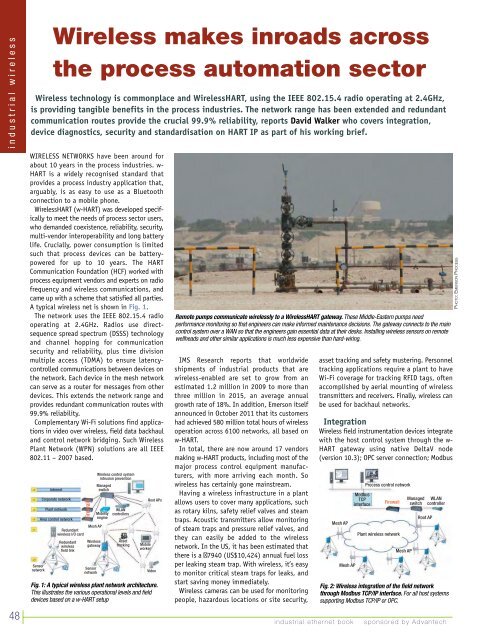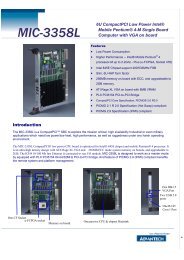industrial wireless book special edition - Networking ...
industrial wireless book special edition - Networking ...
industrial wireless book special edition - Networking ...
You also want an ePaper? Increase the reach of your titles
YUMPU automatically turns print PDFs into web optimized ePapers that Google loves.
<strong>industrial</strong> <strong>wireless</strong><br />
48<br />
Wireless makes inroads across<br />
the process automation sector<br />
Wireless technology is commonplace and WirelessHART, using the IEEE 802.15.4 radio operating at 2.4GHz,<br />
is providing tangible benefits in the process industries. The network range has been extended and redundant<br />
communication routes provide the crucial 99.9% reliability, reports David Walker who covers integration,<br />
device diagnostics, security and standardisation on HART IP as part of his working brief.<br />
WIRELESS NETWORKS have been around for<br />
about 10 years in the process industries. w-<br />
HART is a widely recognised standard that<br />
provides a process industry application that,<br />
arguably, is as easy to use as a Bluetooth<br />
connection to a mobile phone.<br />
WirelessHART (w-HART) was developed specifically<br />
to meet the needs of process sector users,<br />
who demanded coexistence, reliability, security,<br />
multi-vendor interoperability and long battery<br />
life. Crucially, power consumption is limited<br />
such that process devices can be batterypowered<br />
for up to 10 years. The HART<br />
Communication Foundation (HCF) worked with<br />
process equipment vendors and experts on radio<br />
frequency and <strong>wireless</strong> communications, and<br />
came up with a scheme that satisfied all parties.<br />
A typical <strong>wireless</strong> net is shown in Fig. 1.<br />
The network uses the IEEE 802.15.4 radio<br />
operating at 2.4GHz. Radios use directsequence<br />
spread spectrum (DSSS) technology<br />
and channel hopping for communication<br />
security and reliability, plus time division<br />
multiple access (TDMA) to ensure latencycontrolled<br />
communications between devices on<br />
the network. Each device in the mesh network<br />
can serve as a router for messages from other<br />
devices. This extends the network range and<br />
provides redundant communication routes with<br />
99.9% reliability.<br />
Complementary Wi-Fi solutions find applications<br />
in video over <strong>wireless</strong>, field data backhaul<br />
and control network bridging. Such Wireless<br />
Plant Network (WPN) solutions are all IEEE<br />
802.11 – 2007 based.<br />
Sensor<br />
network<br />
Internet<br />
Corporate network<br />
Plant network<br />
Area control network<br />
Redundant<br />
<strong>wireless</strong> I/O card<br />
Redundant<br />
<strong>wireless</strong><br />
field link<br />
Firewalls<br />
Mesh AP<br />
Wireless<br />
gateway<br />
Sensor<br />
network<br />
Wireless control system<br />
intrusion prevention<br />
Managed<br />
switch<br />
Mobility<br />
engine<br />
WLAN<br />
controllers<br />
Asset<br />
tracking<br />
Mobile<br />
worker<br />
Root APs<br />
Video<br />
Fig. 1: A typical <strong>wireless</strong> plant network architecture.<br />
This illustrates the various operational levels and field<br />
devices based on a w-HART setup<br />
Remote pumps communicate <strong>wireless</strong>ly to a WirelessHART gateway. These Middle-Eastern pumps need<br />
performance monitoring so that engineers can make informed maintenance decisions. The gateway connects to the main<br />
control system over a WAN so that the engineers gain essential data at their desks. Installing <strong>wireless</strong> sensors on remote<br />
wellheads and other similar applications is much less expensive than hard-wiring.<br />
IMS Research reports that worldwide<br />
shipments of <strong>industrial</strong> products that are<br />
<strong>wireless</strong>-enabled are set to grow from an<br />
estimated 1.2 million in 2009 to more than<br />
three million in 2015, an average annual<br />
growth rate of 18%. In addition, Emerson itself<br />
announced in October 2011 that its customers<br />
had achieved 580 million total hours of <strong>wireless</strong><br />
operation across 6100 networks, all based on<br />
w-HART.<br />
In total, there are now around 17 vendors<br />
making w-HART products, including most of the<br />
major process control equipment manufacturers,<br />
with more arriving each month. So<br />
<strong>wireless</strong> has certainly gone mainstream.<br />
Having a <strong>wireless</strong> infrastructure in a plant<br />
allows users to cover many applications, such<br />
as rotary kilns, safety relief valves and steam<br />
traps. Acoustic transmitters allow monitoring<br />
of steam traps and pressure relief valves, and<br />
they can easily be added to the <strong>wireless</strong><br />
network. In the US, it has been estimated that<br />
there is a 7940 (US$10,424) annual fuel loss<br />
per leaking steam trap. With <strong>wireless</strong>, it’s easy<br />
to monitor critical steam traps for leaks, and<br />
start saving money immediately.<br />
Wireless cameras can be used for monitoring<br />
people, hazardous locations or site security,<br />
<strong>industrial</strong> ethernet <strong>book</strong><br />
asset tracking and safety mustering. Personnel<br />
tracking applications require a plant to have<br />
Wi-Fi coverage for tracking RFID tags, often<br />
accomplished by aerial mounting of <strong>wireless</strong><br />
transmitters and receivers. Finally, <strong>wireless</strong> can<br />
be used for backhaul networks.<br />
Integration<br />
Wireless field instrumentation devices integrate<br />
with the host control system through the w-<br />
HART gateway using native DeltaV node<br />
(version 10.3); OPC server connection; Modbus<br />
Mesh AP<br />
Mesh AP<br />
Modbus<br />
TCP<br />
interface<br />
Process control network<br />
Firewall<br />
Plant <strong>wireless</strong> network<br />
Mesh AP<br />
Managed<br />
switch<br />
Root AP<br />
WLAN<br />
controller<br />
Fig. 2: Wireless integration of the field network<br />
through Modbus TCP/IP interface. For all host systems<br />
supporting Modbus TCP/IP or OPC.<br />
sponsored by Advantech<br />
PHOTO: EMERSON PROCESS

















